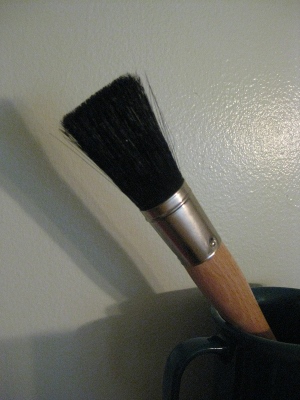(With apologies to the actual Not Martha. Real Martha, America’s favorite domestic diva and best-known upper-crust felon, wouldn’t be impressed with this project, either, but there you go.)
Our pull-down attic stair was replaced recently, first, with a horrible, flimsy aluminum ladder that swayed when it was looked at, and then by a sturdy wood ladder which has its own shortcomings, but is stable and strong. I’ve finally stained and sealed the attic panel and trim. Here it is, taped up and nearly ready for my tender ministrations:
The carpenter who did both installations was apparently pretty annoyed at having to re-do his first faulty job, and, whether through pique, carelessness, or incompetence, managed to destroy the trim around the opening when he removed it for the second time. This was a problem, as all of the (matching) trim in the house is 60 years old. The color — ancient varnish and stain from technologies long gone — was not easily replicated.
A really helpful guy at our local hardware store patiently opened can after can of stain for me so that we could figure out what would look as close as possible to the old trim. So this is what I did this week, instead of sewing:
It’s not a perfect match, but it’s very close, and we can live with it.
Both stair sets came with white strings, and flimsy white plastic pull tabs. Control is important when raising these panels, and the plastic tabs were hard to hold onto. A ring would have looked great, but could have led to finger amputation, so I replaced the tab with a T-shaped lawnmower pull handle. The T shape allows us to get, and keep, a good grip without risking any digits, and, as a bonus, it’s also comfortable to hold.
However, the metal faceplate was pretty tacky. I covered it with a little bit of rust-colored Ultrasuede (which should probably be dark brown, instead):
I also replaced the white nylon cord with a sturdier black cord, which won’t show dirt nearly as readily.
Staining the stairs seemed like an unnecessary aggravation, but I did stain and seal the hand rail, since it gets constant use, and holding onto what would have eventually become a grubby rail was not a pleasant prospect:
That aluminum-looking, textured silver stuff above? It’s an insulated cover that isolates the attic from the rest of the house with a thermal barrier; it helps keep heating and cooling bills lower.
I made one other improvement when the ladder was first installed. The pull cords were just threaded through a hole drilled in the wood. I think that’s sloppy, so I added a washer on the inside:
When the cord is pulled down, the inside knot rests against the washer. Continual use of the cord won’t wear away the edges of the washer, as it will an unreinforced hole drilled in bare wood.
Most useful new trick I learned on this project? The helpful fellow at the hardware store sold me this full, round, brush; he said it was the best tool for applying the urethane to the grooved molding trim. It gave me a beautiful result with less effort than a rectangular brush would have required, and far better, and more even, coverage. And it really was much easier to use than a conventional brush.
It’s not sewing, sadly, but it did need doing. Sewing is best, but getting these projects out of the way is satisfying, too, even if it’s a rather different type of satisfaction.







